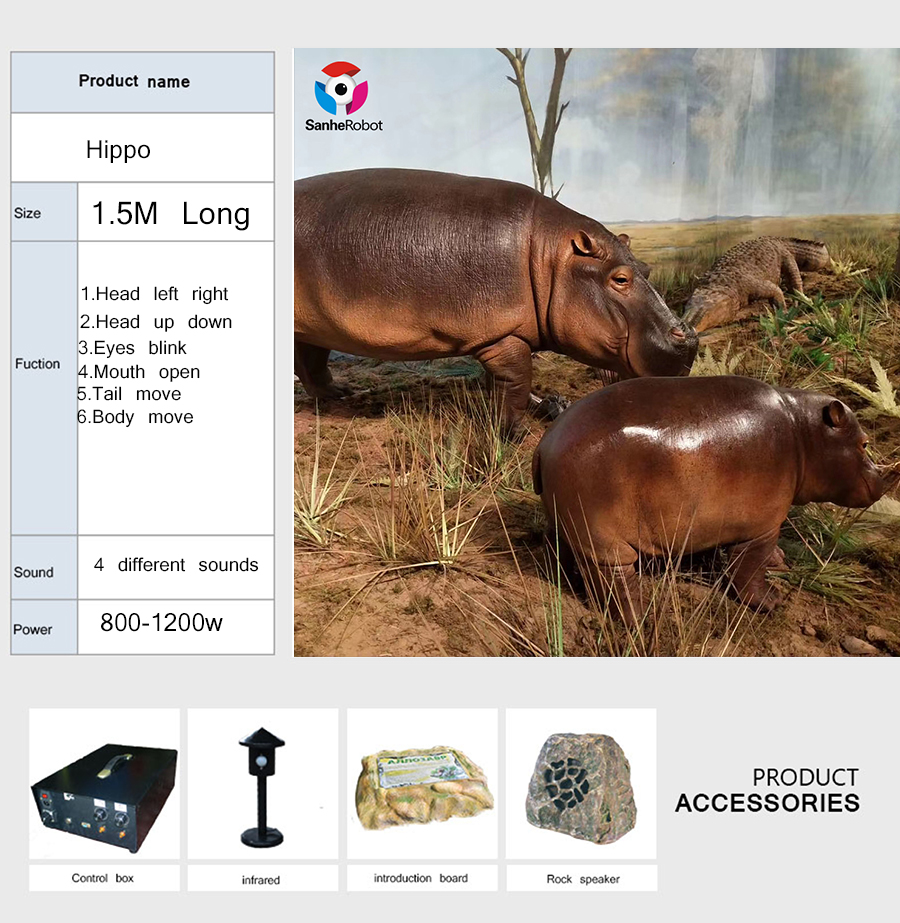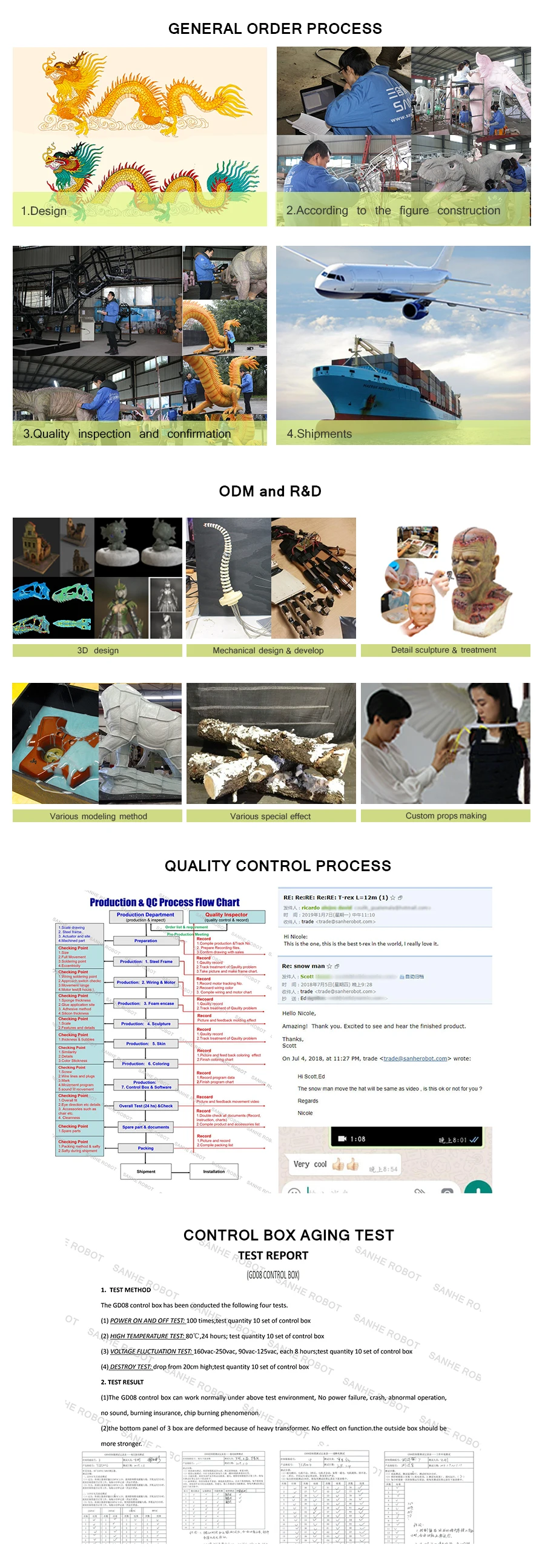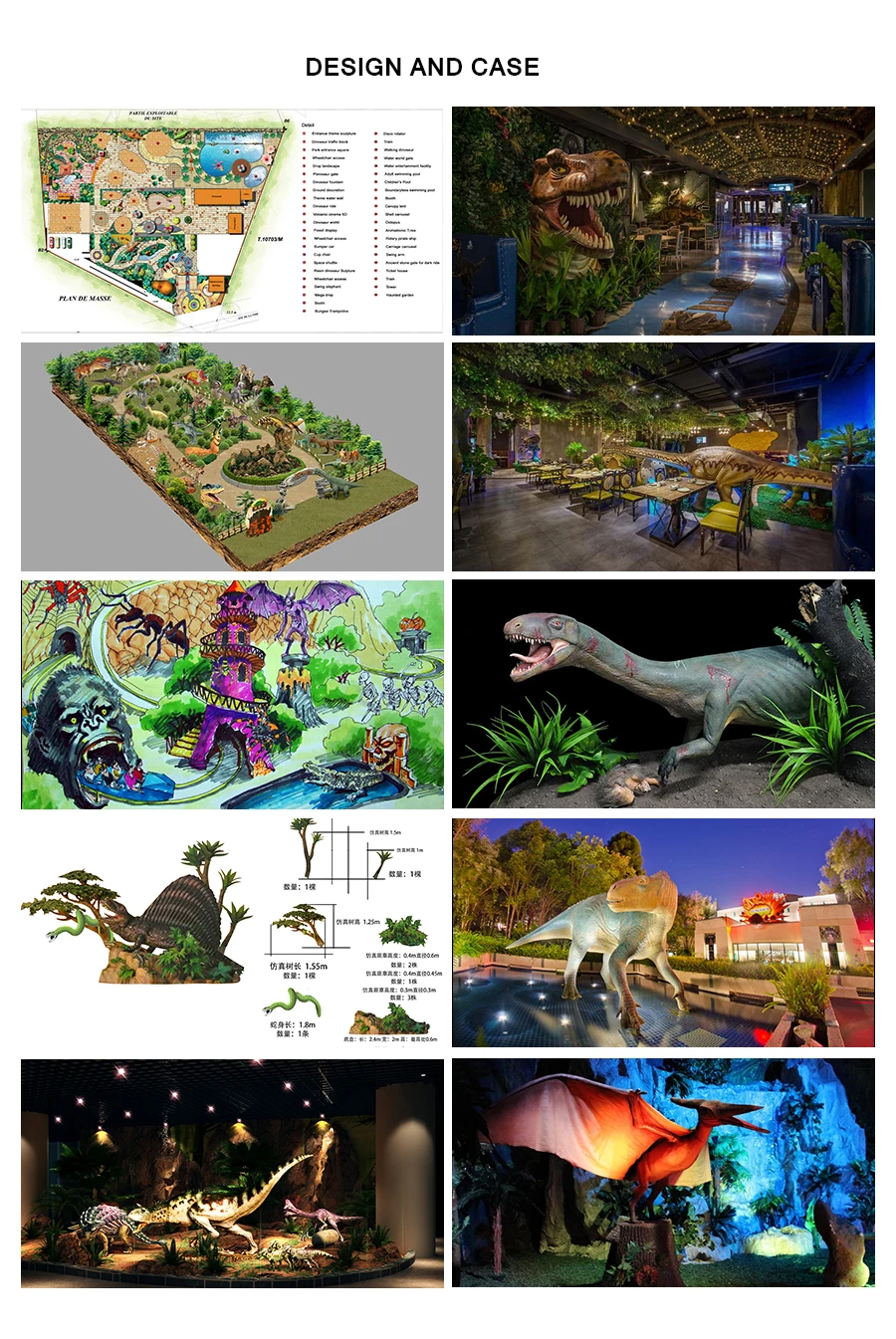

| Input | AC 110/220V ,50-60HZ |
| Plug | Euro plug / British Standard / SAA / C-UL / or depends on request |
| Control mode | Automatic / Infrared / remote / coin / Button / Voice / Touch / Temperature / shooting etc. |
| Waterproofing grade | IP66 |
| Working condition | Sunshine, rain, seaside, 0~50℃(32℉~82℉) |
| Optional function | Sound can be increased to 128 kinds Smoke,/ water. / bleed / smell / change color / change lights / LED screen etc interactive(Location tracking) / conversine(currently only Chinese) |
AFTER-SALE SERVICE
| Service | Need be cut for shipping,fwill provide a detailed installation manual. |
| Warranty | We provide 2 years warranty for all of our antrimatronic models, the warranty pieriod starts from freight arrives at destination port. Our warranty covers motor, reducer, control box, etc. |






 Animatronic animal life-size animal lifelike animal theme park
museum equipment museum replicas museum standard artificial animal prehistoric museum animal replica science museum equipment high quality original size animal model science museum dinosaur exhibition simulation natural animal replica museum display fiberglass zigong prehistoric museum museum equipment artificial fiberglass animal vivid museum quality animal replica natural size artificial museum animal
The hippopotamus also called the hippo, common hippopotamus or river hippopotamus, is a large, mostly herbivorous, semiaquatic mammal and ungulate native to sub-Saharan Africa. It is one of only two extant species in the family Hippopotamidae, the other being the pygmy hippopotamus (Choeropsis liberiensis or Hexaprotodon liberiensis). The name comes from the ancient Greek for "river horse" (?πποπ?ταμο?).
After the elephant and rhinoceros, the hippopotamus is the third-largest type of land mammal and the heaviest extant artiodactyl (in the traditional, non-cladistic sense of the term, not including cetaceans). Despite their physical resemblance to pigs and other terrestrial even-toed ungulates, the closest living relatives of the Hippopotamidae are cetaceans (whales, dolphins, porpoises, etc.), from which they diverged about 55 million years ago. Hippos are recognisable by their barrel-shaped torsos, wide-opening mouths revealing large canine tusks, nearly hairless bodies, columnar legs and large size; adults average 1,500 kg (3,310 lb) for males and 1,300 kg (2,870 lb) for females. Despite its stocky shape and short legs, it is capable of running 30 km/h (19 mph) over short distances.
Hippos inhabit rivers, lakes, and mangrove swamps, where territorial males preside over a stretch of river and groups of five to thirty females and young hippos. During the day, they remain cool by staying in the water or mud; reproduction and childbirth both occur in water. They emerge at dusk to graze on grasses. While hippos rest near each other in the water, grazing is a solitary activity and hippos are not territorial on land. The hippo is among the most dangerous animals in the world due to its highly aggressive and unpredictable nature. They are threatened by habitat loss and poaching for their meat and ivory canine teeth.
Animatronic animal life-size animal lifelike animal theme park
museum equipment museum replicas museum standard artificial animal prehistoric museum animal replica science museum equipment high quality original size animal model science museum dinosaur exhibition simulation natural animal replica museum display fiberglass zigong prehistoric museum museum equipment artificial fiberglass animal vivid museum quality animal replica natural size artificial museum animal
The hippopotamus also called the hippo, common hippopotamus or river hippopotamus, is a large, mostly herbivorous, semiaquatic mammal and ungulate native to sub-Saharan Africa. It is one of only two extant species in the family Hippopotamidae, the other being the pygmy hippopotamus (Choeropsis liberiensis or Hexaprotodon liberiensis). The name comes from the ancient Greek for "river horse" (?πποπ?ταμο?).
After the elephant and rhinoceros, the hippopotamus is the third-largest type of land mammal and the heaviest extant artiodactyl (in the traditional, non-cladistic sense of the term, not including cetaceans). Despite their physical resemblance to pigs and other terrestrial even-toed ungulates, the closest living relatives of the Hippopotamidae are cetaceans (whales, dolphins, porpoises, etc.), from which they diverged about 55 million years ago. Hippos are recognisable by their barrel-shaped torsos, wide-opening mouths revealing large canine tusks, nearly hairless bodies, columnar legs and large size; adults average 1,500 kg (3,310 lb) for males and 1,300 kg (2,870 lb) for females. Despite its stocky shape and short legs, it is capable of running 30 km/h (19 mph) over short distances.
Hippos inhabit rivers, lakes, and mangrove swamps, where territorial males preside over a stretch of river and groups of five to thirty females and young hippos. During the day, they remain cool by staying in the water or mud; reproduction and childbirth both occur in water. They emerge at dusk to graze on grasses. While hippos rest near each other in the water, grazing is a solitary activity and hippos are not territorial on land. The hippo is among the most dangerous animals in the world due to its highly aggressive and unpredictable nature. They are threatened by habitat loss and poaching for their meat and ivory canine teeth.

+86-813-2104677

info@sanherobot.com

+86-13990010824

No.13 Huixin Road, Yantan Town, Yantan District, Zigong City, Sichuan Province, China